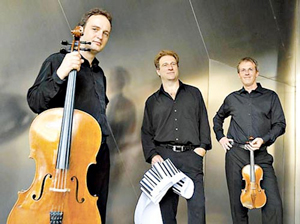by Nicholas Jones

Beethoven was represented by the quirky “Kakadu” variations. It took a Beethoven to make the slightest of material — a trivial popular song (“I am the tailor Cockatoo”) — into a technically demanding set of variations. Full of the composer’s typical contrasts, these variations provided excellent ground for musical acrobatics by these very accomplished instrumentalists — pianist Stefan Mendl, cellist Matthias Gredler, and (the newest member of the group) violinist Bogdan Božović.
The Vienna players made the most of opportunities for excitement: all froth at one moment, and Sturm und Drang the next! But the surprises went further than mere showmanship: Beethoven bookended his show-off variations with significantly more profound writing — a beautiful extended Adagio at the start, and a matching variation near the end — and the performers took us into that seriousness as well as the fun.
The Vienna Trio painted its sound with rich, contrasting colors, booming with Beethovenian ferocity when called for, and then, in an instant, pulling back to the kind of delicate intensity that stimulates the ear even more than volume. Playing with flexibility and panache, they brought to the music the kind of togetherness that comes from being a dedicated ensemble, not just an ad hoc collection of three excellent musicians.
The second piece, and the second surprise, was Arnold Schoenberg’s Verklärte Nacht (“Transfigured Night”). Often played as a piece for string orchestra, it was originally written for string sextet (in 1899). If one knew Schoenberg only by his reputation as an austere, twelve-tone modernist, one might well be surprised to encounter the rich, late-Romantic language of this tone poem. A further surprise in this concert was to hear it in this arrangement for piano trio by the Austrian pianist Eduard Steuermann, a frequent collaborator with Schoenberg.
Contrast and coloration are the essential elements of Verklärte Nacht, and — as with the Beethoven — these were abundant in the Vienna’s performance. But while the Beethoven benefitted from a degree of amused detachment in the playing, the Schoenberg — a passionate narrative of guilt and forgiveness — demands sustained intensity over the whole arc of the piece, some 25 or 30 minutes long. The Vienna players gave us a profoundly committed reading, articulating the changes of mood without ever losing their expressive through-line.
As a piano trio, this complex piece is less successful than as a string sextet. The compression of its multiple voices (necessary in reducing the forces) strips the piece of some of the density that is central to its impact. The percussive articulation of the keyboard (an essential aspect of a piano trio, of course) gives, paradoxically, too much clarity to a piece that is so committed (like Schoenberg’s contemporary, Freud) to demonstrating the mysteries of human emotion and interaction.
Another surprise came after intermission in the very familiar Brahms Piano Trio in B, op. 8. While it started out as expected with its unforgettably gorgeous cello melody, a few minutes into the first movement, it became a piece that for me, at least, seemed quite unfamiliar. Most trios play the version that Brahms revised late in his life, wonderful in its own right. But this was the rarely-played original version, the one which the young Brahms took to Düsseldorf when he visited Clara and Robert Schumann in 1853, and which puzzled Clara.
Puzzling indeed, though fascinating as well. Interspersed in Brahms’s unmistakably Romantic combination of lyricism and restless energy, this version also features strange dialogues of imitation, disconcerting shifts of key, and even a full-fledged and angular fugue. It sounds at times as if 19th-century sonata form had somehow been grafted onto Bach’s The Art of Fugue. A little pizzicato episode near the end of the second movement nearly turns a Mendelssohn-like scherzo into a piece of cool jazz, a seeming precursor to Dave Brubeck.
While the program notes (perhaps supplied by the Vienna Trio, though unsigned) were generally helpful, they were not clear enough in explaining just what version of the Brahms was being performed, implying that the unfamiliar elements were introduced in the composer’s process of revision rather than being original.
The audience gave a very warm ovation after the Brahms, and the trio gracefully responded with an encore, the lovely Andante con moto tranquillo from Mendelssohn’s first piano trio.
Congratulations to the Rocky River Chamber Music Society for presenting the Vienna Piano Trio, who are near the beginning of a busy, 10-day North American tour. It was great to see so many chamber music aficionados out on a Monday night; but…where were the young people?
Published on ClevelandClassical.com March 10, 2015.
Click heree for a printable copy of this article



